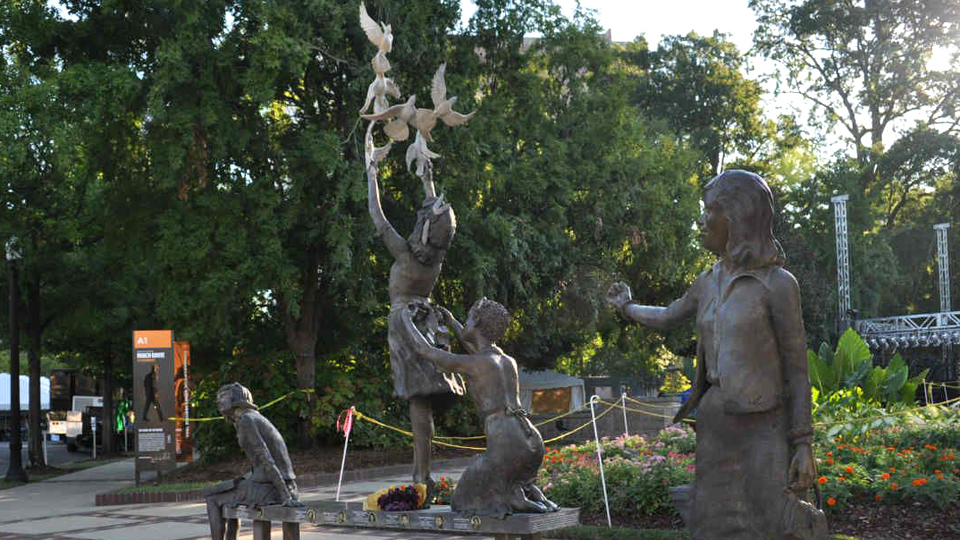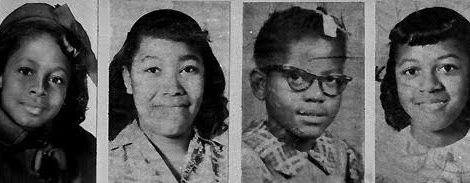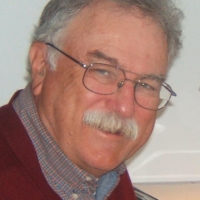
Many martyrs died in the cause of freedom during the civil rights revolution of the 1950s and 1960s. None touched the conscience of the nation and the world more deeply than the terrorist murder Sunday, Sept. 15, 1963, of Addie Mae Collins, Cynthia Wesley, Denise McNair and Carole Robertson.

The girls, ranging in age from 11 to 14, were in the ladies’ room in the basement of Birmingham’s 16th Street Baptist Church that bright morning. They had left Bible classes early because it was the church’s annual “Youth Day” and they were primping for their role, dressed in white from head to toe, in leading the main service at 11 o’clock.
Mamie H. Grier, superintendent of the church’s Sunday school, was the last adult to see the girls alive, talking excitedly about the beginning of the new school year, in which Birmingham was facing a school desegregation order.
An explosion erupted beneath the brick staircase in front of the church, blowing in the foundation wall and burying the four girls in a mountain of rubble, flames, smoke and ash. The girls apparently died instantly, while others arriving for morning services were badly injured. The heinous crime sent shock waves across a city already convulsed by the struggle against segregation.
The bombing took place two weeks after the Aug. 28, 1963, March on Washington for Jobs and Freedom led by Dr. Martin Luther King, Jr. Many saw the bombing as Ku Klux Klan revenge for that immense outpouring in which African-American people, joined by tens of thousands of trade unionists and other fighters for equality, delivered a message to President John F. Kennedy and the Congress: segregation must go!
Yet even without the march on the nation’s capital, the segregationists had ample reason to target the 16th Street Baptist Church as well as Rev. Fred Shuttlesworth’s Bethel Baptist Church a few blocks away. Shuttlesworth’s church and home had been bombed twice earlier. The civil rights movement in Birmingham had been meeting in the sanctuaries of these churches to plan the street demonstrations by thousands of Black youth who confronted the police dogs and fire hoses of police chief Bull Connor and the racist fulminations of Alabama Gov. George Wallace.
In his Pulitzer Prize-winning “Parting the Waters,” Taylor Branch devotes a chapter to what he calls “The Children’s Miracle,” in which youngsters, some of them only six years old, poured into the streets to protest segregation. Connor’s response was to arrest them all. At one point more than 600 youth were packed into Birmingham’s jails, sometimes 40 or more to a cell. Connor thought he could crush the movement. But in fact, the strategy of King, Shuttlesworth and other leaders of this non-violent revolution was to fill Birmingham’s jails with protesting youth to expose to the world the immorality of Jim Crow.
Footage of the brutal police assault on these peaceful demonstrators was aired on network television and on the front pages of newspapers, arousing the nation to the injustice of segregation, a system so vicious that African Americans could not drink from the same water fountain as whites, or check in to a white hotel or eat in a “whites only” restaurant.
All these memories flooded back last week with the conviction on first-degree murder charges of Klansman Bobby Frank Cherry, 77, for his role in the murder of the girls. Shuttlesworth, who led the struggle in Birmingham during the 1950s and 1960s, was present in the courtroom when the verdict was handed down.
“I’m thankful that it came at last, but justice delayed so long is not true justice,” he told the World in a telephone interview from his home in Cincinnati, where he has been a preacher for many years. “It should have been done 39 years ago. All the facts, all the names, were known by the officials from J. Edgar Hoover on down. They knew what was going on. They were in cooperation with the Klan. That perverted justice.”
The media treated the trial of Cherry largely as the closing of the books on a sordid chapter in U.S. history best forgotten. There are even articles in The New York Times about “forgiveness” and “reconciliation” as if the racism that cost these girls their lives has been eradicated.
Yet the trial in Birmingham brought into sharp focus the deep roots of a brand of terrorism that began decades and even centuries before the Sept. 11 terrorist attack on the World Trade Center and the Pentagon. The young girls’ names are on a long roster of victims of “homegrown” terrorists who continue to murder people of color today.
Shuttlesworth recalled the case of James Byrd, Jr., who was dragged to his death behind a pickup truck by Klansmen in 1999 in Jasper, Texas. (Then-governor George W. Bush refused to support the James Byrd, Jr., Hate Crimes bill in a meeting with Byrd’s grieving family. It was enacted into law after Bush was installed in the White House).
Terrorist Timothy McVeigh was a fanatic white supremacist who bombed the federal building in Oklahoma City in revenge against the growing multiracial and multicultural composition of the United States. Much of the racist terror today is committed by officers in uniform, as attested in the shooting in New York City of Amadou Diallo in a hail of 41 bullets. The officers, all white, were acquitted of the murder of this innocent West African street merchant.
Even so, Rev. Shuttlesworth stressed that the life sentence meted out to Cherry marks “the end of an era,” in which the Klan lynched with impunity and without remorse. “It was an era of intrigue and subversion of justice by law enforcement authorities in the South,” he said. “The Klan was tolerated because they were doing what those in positions of power wanted, keeping Black people in their place. We can’t forget that America started out with slavery.”
The task of eradicating the system of racist oppression, Shuttlesworth said, “was never completed after the civil war. Attempts were made but compromises left the task unfinished. The injustice continues in the guise of ‘States Rights.’”
Shuttlesworth said the struggle that cost the girls their lives won enactment of the landmark 1964 Civil Rights Act. The struggle, he said, is focused on economic and social injustice. “Why are there 60 million people without health care in this country?” he demanded. “Why do so many people sleep homeless on our streets? Why is there no affordable housing? It’s all caused by wickedness in high places.”
He questioned the Bush administration’s “war on terrorism,” declaring, “Bombing people’s homes can never bring about peace. We are becoming deluded with the idea of being a superpower. We are developing a psychosis of war in the guise of hunting terrorists. Sometimes, men with sinister intentions can use God’s words for evil ends.”
Shuttlesworth is a giant of the civil rights movement who stirred his congregation and the people of Birmingham into the struggle against segregation seven years before it flared into massive street confrontations in 1963. It was Shuttlesworth who convinced Dr. King to bring his civil rights crusade to Birmingham.
“Martin grew into a great speaker,” he said, describing King as a prophet, the “voice of God.” Yet, he added, “Martin had to be pushed and I was the pusher. I told him we were living in a city with 40 percent Black population but zero percent of the privileges. I said ‘Martin, we’re 6,000 miles from South Africa but we’re six inches from apartheid.”
His views are shared by the Rev. C.T. Vivian of Atlanta, one of Dr. King’s closest comrades-in-arms and a top leader of the Southern Christian Leadership Conference (SCLC).
Vivian told the World he remembers being at an airport when news flashed of the church bombing and the death of the four girls. “There were so many Klan bombings of Birmingham’s Black community then that we called it ‘Bombingham,’” he said.
The guilty verdict in the trial of the Klansman, he said, “Proves that we conducted the non-violent struggle in a way that left things on the conscience of the nation. We’re trying to understand how long it takes for the nation to demand justice for what was done to Black people 40 years ago. It allows us to understand how deep racism is in this nation and the sacrifices needed to bring it to the surface so that people can not only admit it but demand justice. It shows the gap between the importance attached to Black life and white life. Until that gap is closed, we cannot expect to have freedom and proper treatment of poor and Black people in this country.”
The struggle, now, he said, is to achieve social and economic equality while defending and expanding rights already won, voting rights, for example, trampled in the 2000 presidential election.
As director of SCLC affiliates, Vivian played an important role in the civil rights projects in Montgomery, Birmingham, St. Augustine and Selma. The struggle in Birmingham and the murder of the little girls set the stage for the Selma voting rights campaign and the Selma-Montgomery march that culminated in the passage of the Voting Rights Act of 1965.
“No one who is involved in a struggle for freedom and justice dies in vain,” Vivian said. “We are all part of the whole. We all gain our sense of freedom based on how we respond to the death and suffering of anyone who stands for those freedoms.”
One of Vivian’s favorite works of art is a painting by the African-America artist, John Biggers, titled, “Birmingham: Children of the Morning.” It depicts four children walking toward their church, their faces filled with hope in the future. He recalled, as well, the luminous stained glass windows made in Scandinavia and installed in the 16th Street Church as a memorial to the four slain girls.
The aim of the bombing, as well as Bull Connor’s police repression, Vivian said, “was to frighten the people so they would give up their demands for justice. They bombed Dr. King’s home, Abernathy’s home, Shuttlesworth’s home. But it didn’t work. Every act of violence against a movement for human rights helps the people see how pernicious, how evil the opposition is. They might have taken the Klan lightly before. Now they could no longer dismiss them. They saw them as stone-cold murderers. The death of these little girls created a decision in the minds of the people of the world that the system of segregation had to end.”
Dr. King’s eulogy for the girls rings across the decades: “These children – unoffending, innocent and beautiful – were the victims of one of the most vicious, heinous crimes ever perpetrated against humanity,” he said in the funeral at Sixth Ave. Baptist Church in Birmingham. “They say to each of us, Black and white, that we must substitute courage for caution. They say to us that we must be concerned not merely about who murdered them but about the system, the way of life and the philosophy which produced the murderers.”
He added, “The innocent blood of these little girls may well serve as the redemptive force that will bring new light to this dark city. The holy scripture says, ‘A little child shall lead them.’ The death of these little children may lead our whole Southland from the low road of man’s inhumanity to man to the high road of peace and brotherhood.”










